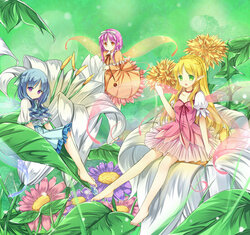Moegirlpedia would welcome your assistance in improving this article☆Kira~
As you read this article, you're welcome to participate in editing this page. Before editing, please read the wiki quickstart, editing guidelines and retrieve relevant information. We wish you a good time on Moegirlpedia. |
 | |
| Base Info | |
| Moe Point | Fairy |
|---|---|
| Moe Point Synonyms | Sprite |
| Symbolic Characters | Tinkerbell |
| Related Moe Points | immortality, wings, miniature girl, elf |
A fairy is a kind of fictional creature found in Western fantasy works, it is a kind of nature spirit.
Origin
According to the research of Japanese scientist Junie Inomura, the origin of the word fairy traces back to the Latin fatum (plural fata), meaning "fate" or "destiny". The derived word fatum means "to work magic, to confuse", later transferred to the French noun faer or feer, meaning "enchanted" or "bewitched". It then evolved to the medieval French noun feerie (meaning "illusion" or "magic"). The word evolved with the times after it was introduced to England as fayerye, faery, pharie and faerie, until it finally became fairy.
Powers of a fairy
- Transformation powers
- Most fairies are able to change their size, or turn into other creatures and inorganic beings. Some fairies can change others' appearance.
- Immortality
- The general impression is that fairies don't age or die, and have no lifespan limit. There are actually quite a few stories about fairies growing up and having children.
- Making medicine
- Fairies are good at healing, and know how to make healing medicines, there are also medicines with magic powers.
- Power to fly
- The impression that fairies have wings is more passable, in fact there are few fairies with wings in legend. Most fairies fly by using spells.
- Alchemy
- Fairies have better alchemy skills than humans, certain fairies will also help humans with their work while they are asleep.
- Pranking humans
- In legend, fairies could use their magic to play tricks on people, such as causing them to get lost, creating illusions, hiding things, tangling their hair, angering people, paralyzing their body, etc.
Image evolution
In terms of the broad sense of the "fair folk", there are roughly four types of their appearance. The first was an anthropomorphism of nature, personifying natural phenomena such as rainbows, earthquakes, storms, etc. The second was in ancient Irish mythology; because of the influence of Christianity, many mythical and legendary deities became a part of folklore. The third are elementals and nature spirits in the concept of alchemy, the fourth is the soul of the dead.
In the 9th and 10th century, Christianity came to Ireland, and the gods of ancient Caird mythology were demonized, and the lesser deities associated with the gods became "fairies" in Irish folklore. During the Renaissance of the 14th century, fairies became one of the popular artistic subjects at the time. For example, in Shakespeare's A Midsummer Night's Dream, fairies could turn into beautiful women or handsome men. In the Industrial Revolution of the 18th century, fairy-related art continued to grow, and the image of the fairy with "translucent insect wings" was gradually formed. This image had also found its way to children's literature, such as in Peter Pan.
Other images (simplified versions may be due to performance, budget, etc.):
- A light orb shaped like a human head (Fairy avatar in Warcraft 3)
- A light orb with insect wings (Fairy model in The Legend of Zelda: Phantom Hourglass)
- A light orb (Fairy model in Warcraft 3)
- A glowing butterfly (Spring model, dark elf base model in Warcraft 3)
Characters with this moe point
- Cirno, Star Sapphire (Touhou Project)
- Yui (Sword Art Online)
- Tinkerbell, Silvermist, Iridessa, Rosetta, Fawn (Tinkerbell series)
| ||||||||||||||||||||||||||||||||||||||||||||||||||||||||||||||||||||||||||||||||||||||||||||||||||||||||||||||||||||||||||||||||||||||||||||||||||||||||||